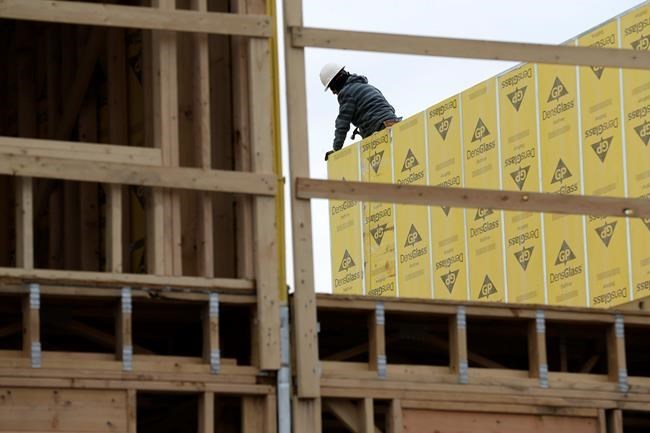
FILE- In this Monday, Feb. 26, 2018, photo, work continues on a new development in Fair Lawn, N.J. On Friday, March 9, the Labor Department reports its job and wages data for February. (AP Photo/Seth Wenig, File)
Republished March 09, 2018 - 12:04 PM
Original Publication Date March 09, 2018 - 12:06 AM
WASHINGTON - U.S. employers went on a hiring binge in February, adding 313,000 jobs, amid rising business confidence lifted by the Trump administration's tax cuts and a resilient global economy.
The surprisingly robust hiring, reported by the Labor Department on Friday, was the strongest in 1 1/2 years.
It was accompanied by the biggest surge in 15 years in the number of people either working or looking for work. That kept the nation's unemployment rate unchanged for a fifth straight month at 4.1 per cent.
At the same time, average wage growth slowed to 2.6 per cent in February from a year earlier. That was down from January's revised pace of 2.8 per cent, which had spooked investors because it raised fears of inflation.
The hiring boom caught many economists off guard, because they expected a smaller — though still healthy — increase. Job gains typically slow as the unemployment rate falls, because companies run out of workers to hire.
The economy has expanded for 104 straight months, or nearly nine years, the third-largest expansion on record, and hiring often declines as recessions fade further into the past.
Yet job growth has accelerated in recent months. Companies have added an average of 242,000 jobs a month over the past three months, above 2017's pace of 182,000.
"The February employment report was unambiguously strong, confirming that the U.S. labour market is on fire," said Michelle Girard, chief U.S. economist at NatWest Markets. "The pace of job growth is gaining momentum — a very impressive development at this stage of the economic cycle."
The Trump administration's tax cuts appear to have lifted optimism among consumers and businesses. U.S. employers have also benefited from a strengthened global economy. And consumers are more confident than they have been since 2000.
Investors celebrated the news, sending the Dows Jones industrial average up 390 points in early afternoon trading. The muted wage growth is a relief to Wall Street, because faster raises could spur higher inflation and additional interest rate increases from the Federal Reserve.
The picture drawn by Friday's jobs report is a mixed one for the Fed, which seeks to raise short-term interest rates at just the right pace: enough to forestall inflation but not so fast as to slow economic growth.
The Fed is considered certain to raise rates when it next meets in two weeks. The question is whether it will do so a total of three times this year — or, in light of the job market's strength and the prospect of a pickup in inflation, four times.
The economy has now gained jobs for 89 straight months, the longest streak on record. That has helped address many of the nation's long-term problems dating to the Great Recession.
For example, more Americans are coming off the sidelines and looking for work, reversing a trend from the first few years after the downturn when many of the unemployed gave up on the job hunt and stopped looking.
The proportion of adults working or looking for work jumped to 63 per cent from 62.7 per cent, still far below its pre-recession levels in 2007. But it has stabilized in the past three years, even as millions of baby boomers have retired. That suggests that enough younger people are stepping in to offset those retirements.
In fact, the proportion of adults in their prime working years — defined as ages 25 to 54 — with jobs rose sharply to 79.3 per cent, just a few tenths of a point below its pre-recession level.
Economists have found that figure is closely related to wage growth: The higher it rises, the more employers have to offer higher pay to find the workers they need. That suggests that wage growth may accelerate soon.
Higher-paying, blue-collar industries reported some of the biggest increases. Construction firms added 61,000 jobs, a figure that may have been inflated by relatively warm weather last month. Still, that is the biggest gain for construction since 2007.
Manufacturing companies added a solid 31,000 jobs. Retailers added 50,000, the most in two years, though that figure was probably inflated by the fact that stores laid off fewer temporary workers after the holidays because they hired fewer than in previous years. Financial services gained 28,000, the biggest increase since 2005.
In the meantime, economists are calculating how the Trump administration's decision Friday to impose a 25 per cent tariff on steel imports and a 10 per cent tariff on aluminum might affect the job market.
The Trade Partnership, a consulting firm, estimates that the tariffs could eliminate 145,000 jobs. Still, the administration has opened the door to so many possible exemptions from the tariffs that an accurate estimate is all but impossible.
Gene Peters, chief executive of Rosnet, a restaurant software company, has had to offer higher pay to attract new workers. He is now offering software developers 20 per cent more in salary than he did just two years ago.
The company is also paying 75 per cent of employees' health care costs, up from 50 per cent. The company, based in Parkville, Missouri, just outside Kansas City, makes data analysis software that helps restaurants track costs and work schedules.
"It's getting more competitive in this market," Peters said. "There are more IT jobs and not as many people."
News from © The Associated Press, 2018